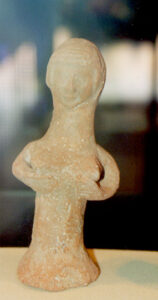Who or What Was Yahweh’s Asherah? André Lemaire, Biblical Archaeology Review (10:6), Nov/Dec 1984.
Startling new inscriptions from two different sites reopen the debate about the meaning of asherah
New inscriptions from two different sites have reopened the debate about the meaning of asherah, a term often used in the Bible. Is it—or she—a goddess? Is it a holy place? Or perhaps a sacred tree? Or a pole? Or possibly a grove of trees? All these suggestions have been proposed at one time or another by scholars.
The question is especially intriguing because, as a result of these new inscriptions, the inquiry now arises in connection with the sacred unpronounceable name of Israel’s God, usually written YHWH, or Yahweh. Whatever an asherah is, Yahweh had one!
The first of these inscriptions came to light, as seems to be the case so often, as a result of an illegal excavation by Bedouin or by Arab farmers. A few months after the Six-Day War of June 1967, when Old and New Jerusalem were reunited, some Iron Age material, including a short Hebrew inscription on limestone cut from a tomb wall, was offered on the Jerusalem antiquities market. All this material, including about 125 pieces of eighth-century B.C. pottery and a collection of iron and bronze implements as well as the inscription, was acquired by Dr. William G. Dever for Hebrew Union College, with which he was then associated.
Read Who or What Was Yahweh’s Asherah? in the online Biblical Archaeology Society Library.





2 Comments on "Who or What Was Yahweh’s Asherah? André Lemaire, Biblical Archaeology Review (10:6), Nov/Dec 1984."
Trackback | Comments RSS Feed
Inbound Links